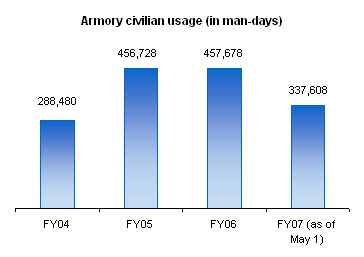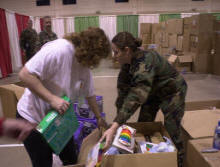 |
DEPARTMENT
RESULTS |
|
|
| |
|
Goal: Prepare units for
mission readiness |
|
Why is this goal important?
The ability of the
Minnesota National Guard to man, equip, and train our Soldiers and Airmen to
operate as an integrated, cohesive unit is critical to mission success. Over
the past few years, the Minnesota National Guard has increasingly been
called upon to serve our nation and state in times of conflict and crisis.
The men and women of the Minnesota National Guard must be prepared to
perform full spectrum military operations that include supporting the war effort in Iraq, security missions in Europe,
homeland security and emergency response missions within the State. Today,
more than 2,800 Soldiers from the 1st Brigade Combat team and nearly 100
Airmen from the 133rd Air Wing and 148th Fighter Wing are currently serving
in Iraq and Afghanistan.
How will this goal be accomplished?
Our ability to have Soldiers and Airmen ready for deployment is a key factor
of our success. To accomplish this, the Minnesota Army National Guard uses an internal Mobilization
Deployment Readiness Evaluation to assess an individual’s readiness for
deployment. During this process, Soldiers are assessed in areas such as
meeting medical standards, medical profiles, personnel records, wills and
family issues. Of the more than 8,000 Soldiers/Airmen deployed since 9-11,
98% successfully met standards when
processed through the federal mobilization station requirements.
What is the department’s progress to date?
As of July 1, 2007,
of the more than 8,000 Soldiers and Airmen deployed since 9-11, 98% of them
successfully pass through US Army mobilization sites, exceeding the 85% Army
goal. Additionally, 100% of our Airmen successfully deploy to theaters
overseas. The following chart reflects our success in deploying Soldiers and
the number of Soldiers/Airmen who have been deployed since 1996.
|
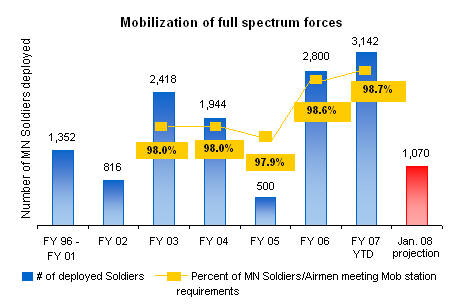
|
|
|
Goal: Recruit and retain |
|
Why is this goal important?
To support the wide
array of missions for which we are tasked, the Minnesota National Guard must
recruit and retain our Soldiers and Airmen. Without sufficient
forces, our ability to simultaneously support missions at home and aboard
may be jeopardized. From a national perspective, a strong strength posture
allows the Minnesota National Guard to retain its current force structure
levels, while seeking additional force structure, resources and future
missions operations.
How will this goal be accomplished?
The Minnesota
National Guard actively pursues recruiting initiatives across the State.
Federal and State incentive programs serve as outstanding recruiting tools
for high school juniors and seniors going on to college. Commanders
throughout the state ensure Soldiers and Airmen receive training in
individual survival skills, occupational skills, military operations and
leadership development. To retain our Soldiers and Airmen we must provide
quality training programs that challenge the abilities of our personnel, and
provide programs that improve the quality of life of our Soldiers, Airmen
and their families.
What is the department’s progress to date?
For this goal, the Department
of Military Affairs monitors two major measures – Assigned End Strength and Annual Attrition
Rate. As of June 2007, 13,469
personnel were assigned to the Minnesota National Guard, for an assigned
strength of nearly 112% of authorized. The Minnesota National Guard
currently ranks first in the nation in recruitment of non-prior service
personnel. Our second measurement reflects the percentage of personnel who leave the Minnesota
National Guard. Our objective is to not exceed an annual percentage rate of
14% per year. As of June 2007, the attrition rate of the Minnesota National
Guard was at 7.8% for the year. Since 2002, the Minnesota National
Guard’s recruiting program has led the nation in production.
In the fall of 2005, while the 1st Brigade
Combat Team was still going through pre-mobilization training at Camp
Shelby, the Minnesota National Guard began to plan for their return. “Beyond
the Yellow Ribbon”, a program pioneered by the Minnesota National Guard
changes the way Soldiers and Airmen reintegrate back to their communities.
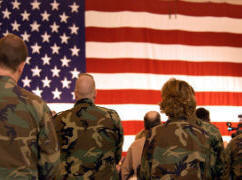 Governor Pawlenty is a staunch supporter of the “Beyond the Yellow Ribbon”
program and has established a committee to coordinate assistance from
various state agencies. In September 2006, strong ties with congressional
representatives, led to Senator Mark Dayton securing $3 million for the
“Beyond the Yellow Ribbon” program. This money supports the Family
Reintegration Academy that brings together all the professional services
available to ease the transition to from Soldier to civilian. It involves a
series of training sessions for Soldiers and family members starting months
before the unit even returns to the United States and continues for 90 days
after the unit returns. Soldiers and their family members learn how to cope
during uncertain times, deal with the emotional effects of war, and personal
skills to help them reconnect with family members. Although initially a
Minnesota Army National Guard initiative, the program now extends to the
Minnesota Air National Guard as well. Today, “Beyond the Yellow Ribbon” is a
national model and is gaining congressional support to expand the program
nation wide. Governor Pawlenty is a staunch supporter of the “Beyond the Yellow Ribbon”
program and has established a committee to coordinate assistance from
various state agencies. In September 2006, strong ties with congressional
representatives, led to Senator Mark Dayton securing $3 million for the
“Beyond the Yellow Ribbon” program. This money supports the Family
Reintegration Academy that brings together all the professional services
available to ease the transition to from Soldier to civilian. It involves a
series of training sessions for Soldiers and family members starting months
before the unit even returns to the United States and continues for 90 days
after the unit returns. Soldiers and their family members learn how to cope
during uncertain times, deal with the emotional effects of war, and personal
skills to help them reconnect with family members. Although initially a
Minnesota Army National Guard initiative, the program now extends to the
Minnesota Air National Guard as well. Today, “Beyond the Yellow Ribbon” is a
national model and is gaining congressional support to expand the program
nation wide.
|
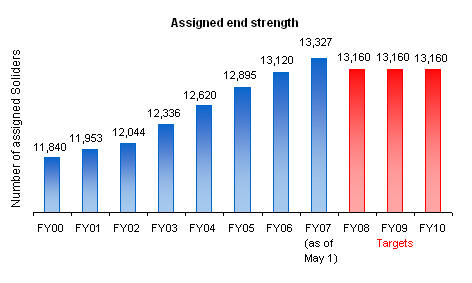 |
|
|
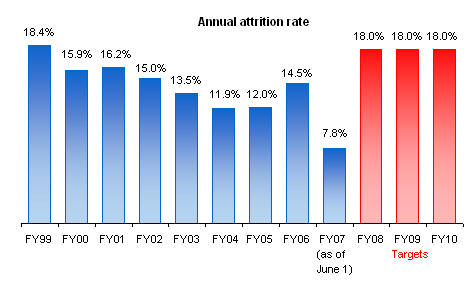 |
|
|
| |
|
Goal:
Be of value to
our communities |
|
Why is this goal important?
As a community-based,
citizen-soldier organization, the Minnesota National Guard believes in
adding value to our communities through community service, education
programs and by opening the doors of our facilities to members of the local
area. This goal reflects the commitment of our leaders and our nearly 13,000
members in adding value to communities across the State.
How will this goal be accomplished?
By regulation, members of the
Minnesota National Guard can spend up to four hours per year performing
community service missions while in a paid status. While the levels of
support vary from year to year based on the number of personnel
deployed, the Minnesota National Guard continues to support local
communities to the maximum extent possible and averages between 25,000 and
30,000 community service hours per year. Service projects include participation in local
parades, funeral honors, speaking engagements, school reading programs,
local clean-ups, and holiday toy shops.
Additionally, we open the
doors to our facilities to the public for family events, community education
and recreation activities.
What is the department’s progress to date?
At this time, the Minnesota National
Guard monitors one major area – Civilian Usage of our Armories. In
June 2004, we began to monitor the number of days civilians use our
Armories. Since then, we have logged nearly 450,000 hours in civilian usage
each year.
|
| |
|
Some images © 2003 www.clipart.com |
|
Last update on
06/13/2007
|
|






